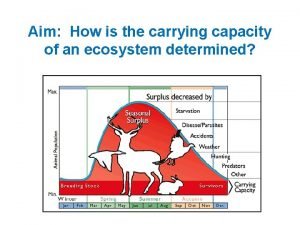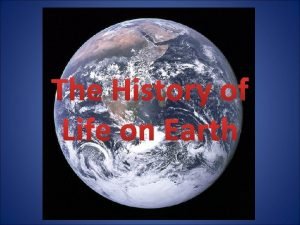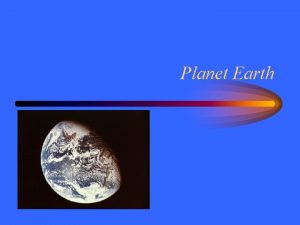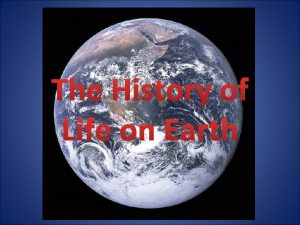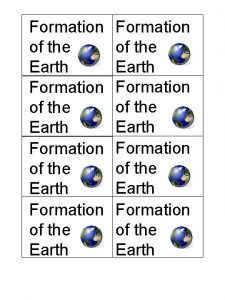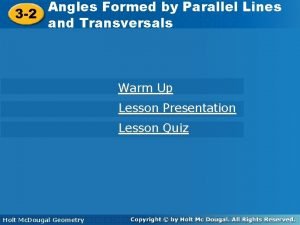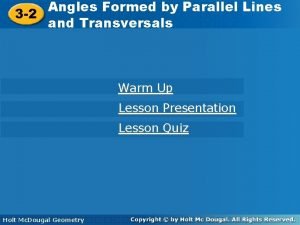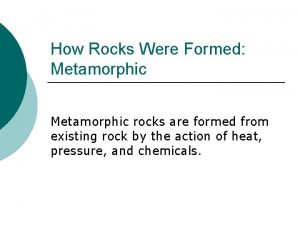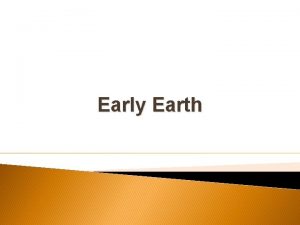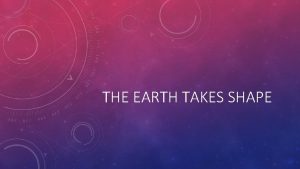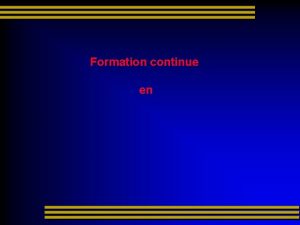Formation of the Earth Earth was formed approx






















- Slides: 22



Formation of the Earth • Earth was formed approx. 4. 54 billion years ago out of the solar nebula. • Initially molten, the outer layer cooled to form a crust about 4. 3 B. Y. A. as water was brought to Earth by meteors. • By 3. 9 B. Y. A. Earth had cooled enough to form oceans.

Formation of the Earth • Out gassing and volcanic activity produced the primordial atmosphere consisting of water vapor, carbon dioxide, hydrogen, ammonia, methane, and other gasses. • The primordial ocean was most likely made up of water, with methane, ammonia, hydrogen, sulfur, and carbon dioxide. • No free oxygen in the atmosphere or oceans at this time.

First Life on Earth • Life – metabolism and reproduction, growth and response to stimuli (adaptation). • Proto-cells: cell-like spheroid formed from proteinoids (chained groups of amino acids). – Proto-cells containing RNA may have been the first cellular life forms on Earth. (3. 8 B. Y. A. )

The First Cells • Prokaryotic cells: Cells without a membranebound nucleus. (3. 5 - 2. 5 B. Y. A. ) – First autotrophs, blue-green algae. (supplied the first oxygen to the atmosphere) – Genetic material is in a circular loop called a plasmid

The First Cells • Eukaryotic cells: cells with a membrane-enclosed nucleus. – Developed approx. 2 billion years ago – Include all complex cells and make up all multi-cellular organisms. • Animals, plants, fungi, and protists are eukaryotes.

Precambrian • Proterozoic Eon – 2500 to 543 mya – Paleoproterozoic Era – 2500 to 1600 mya • Stable continents • 2400 – 2100: Huronian ice age – Mesoproterozoic Era – 1600 to 900 mya • • • Formation of supercontinent Rodinia Eukaryotic cells appear 1200 mya: spore/gamete formation (sexual reproduction) Photosynthetic organisms proliferate, oxygen above 10% Formation of the ozone layer 950 mya: start of Stuartian-Varangian ice age

Precambrian • Proterozoic Eon – 2500 to 543 mya – Neoproterozoic Era – 900 to 643 mya • Earth day is 18 hours long • Formation of a supercontinent Pangea – Cryogenian Period – 850 to 635 mya • 750 mya: End of last magnetic reversal • 650 mya: mass extinction of 70% of dominant sea plants.

Phanerozoic Eon 543 mya to present • Paleozoic Era – 543 to 251 mya – Vendian (Ediacaran) Period – 635 to 543 mya • 570 mya: end of Stuartian-Varangian ice age • Soft-bodied organisms developed, first jellyfish – Cambrian Period – 543 to 490 mya • Most of the major groups of animals first appear. • 530 mya: Animals with shells appeared.

Phanerozoic Eon • Paleozoic Era – 543 to 251 mya – Ordovician Period – 490 to 443 mya • Diverse marine invertebrates, first vertebrates appear, first green plants and fungi on land • 450 mya: start of Andean-Saharan ice age • 443 mya mass extinction of many marine invertebrates. – Silurian Period – 433 to 417 mya • End of Adean-Saharan ice age, stabilization of Earth’s climate • Coral reefs appeared, first fish with jaws, spiders, centipedes and plants appear on land.

Phanerozoic Eon 543 mya to present • Paleozoic Era – 543 to 251 mya – Devonian Period – 417 to 354 mya • • • Ferns and seed-bearing plants appeared, first amphibians Wingless insects and vertebrates appear on land Pannotia fragmented into Laurasia and Gondwana Atmospheric oxygen level about 16% 374 mya: mass extinction of 70% of marine species

Phanerozoic Eon 543 mya to present • Paleozoic Era – 543 to 251 mya – Carboniferous Period – 354 to 299 mya • Mississippian Epoch – 354 to 318 mya – Karoo ice age, large primitive trees, vertebrates appear on land, first winged insects • Pennsylvanian Epoch – 318 to 299 mya – First reptiles, atmospheric oxygen over 30%, giant arthropods, deposits of coal form in Europe and Asia.

Phanerozoic Eon 543 mya to present • Paleozoic Era – 543 to 251 mya – Permian Period – 299 to 251 mya • • • Formation of the supercontinent Pangaea, Earth is cold and dry Conifers appear 260 mya: end of Karoo ice age Oxygen levels drop from 30% to 12% 251 mya: Great Permian-Triassic mass extinction – 90% of ocean dwellers and 70% of land plants and animals.

Phanerozoic Eon 543 mya to present • Mesozoic Era – 251 to 65 mya – Triassic Period – 251 to 200 mya • Breakup of Pangea • First dinosaurs appear, first evidence of mammals • 201 mya: mass extinction 20% of marine animals

Phanerozoic Eon 543 mya to present • Mesozoic Era – 251 to 65 mya – Jurassic Period – 200 to 145 mya • • Earth is warm – no polar ice Age of the dinosaurs: giant herbivores and vicious carnivores. North America splits from Europe. 150 mya: First birds (archaeopteryx) appear

Phanerozoic Eon 543 mya to present • Mesozoic Era – 251 to 65 mya – Cretaceous Period – 145 to 65 mya • Africa and India split from Antarctica, South America splits from Africa • Flowering plants, crocodiles appear, modern mammals and birds developed. • 70 mya: T-Rex thrived • 65 mya: Meteor impact, Yucatan, Mexico – mass extinction of dinosaurs.

Phanerozoic Eon 543 mya to present • Cenozoic Era – 65 mya to today – Tertiary period – 65 to 1. 8 mya • Paleocene Epoch – 65 to 54. 8 mya – Appearance of placental animals – Formation of Rocky Mtns, major global warming Eocene Epoch – 54. 8 to 33. 7 mya India and Asia collide forming the Himalayas, Australia separates from Antarctica. Small modern mammals appear.

Phanerozoic Eon • Cenozoic Era – 65 mya to today – Tertiary period – 65 to 1. 8 mya • Oligocene Epoch – 33. 7 to 23. 8 mya – Start of Pleistocene ice age – Appearance of grasses, elephants, camels, early horses. • Miocene Epoch – 23. 8 to 5. 3 mya – The plants and animals of the Miocene were fairly modern. – Mammals and birds were well-established. Whales, seals, and kelp spread.

Phanerozoic Eon 543 mya to present • Cenozoic Era – 65 mya to today – Tertiary period – 65 to 1. 8 mya • Pliocene Epoch – 5. 3 to 1. 8 mya – Accumulation of ice at the poles – Spread of grasslands, rise of long-legged grazing animals – 2. 4 mya: Homo habilis appears, tool making humanoids

Phanerozoic Eon • Cenozoic Era – 65 mya to today – Quaternary Period – 1. 8 mya to today • Pleistocene Epoch – 1. 8 mya to 10, 000 yrs ago – Homo erectus moves out of Africa – Presence of large land mammals and birds – Global cooling and glaciation – Neanderthals – 500, 000 yrs ago – Homo sapiens – 200, 000 yrs ago

Phanerozoic Eon • Cenozoic Era – 65 mya to today – Quaternary Period – 1. 8 mya to today • Holocene Epoch – 11, 600 ya to today – Development of agriculture and domestication of animals. – 9, 000 ya: metal smelting – 5, 500 ya: wheel – 5, 000 ya: writing – 4, 500 ya: Pyramids – 2, 000 ya: Christian Era – 250 ya: industrialization – 50 ya: Space Travel
 Can less than 150 minnows live in this lake
Can less than 150 minnows live in this lake Approx mining
Approx mining Formation initiale vs formation continue
Formation initiale vs formation continue The earth formed approximately
The earth formed approximately A large crack in the earth formed by a river or earthquakes
A large crack in the earth formed by a river or earthquakes Tư thế ngồi viết
Tư thế ngồi viết Thế nào là giọng cùng tên
Thế nào là giọng cùng tên Voi kéo gỗ như thế nào
Voi kéo gỗ như thế nào Thẻ vin
Thẻ vin Thể thơ truyền thống
Thể thơ truyền thống Sự nuôi và dạy con của hươu
Sự nuôi và dạy con của hươu Từ ngữ thể hiện lòng nhân hậu
Từ ngữ thể hiện lòng nhân hậu Thế nào là hệ số cao nhất
Thế nào là hệ số cao nhất Diễn thế sinh thái là
Diễn thế sinh thái là Slidetodoc
Slidetodoc Vẽ hình chiếu vuông góc của vật thể sau
Vẽ hình chiếu vuông góc của vật thể sau 101012 bằng
101012 bằng Lời thề hippocrates
Lời thề hippocrates Vẽ hình chiếu đứng bằng cạnh của vật thể
Vẽ hình chiếu đứng bằng cạnh của vật thể Tư thế worm breton
Tư thế worm breton đại từ thay thế
đại từ thay thế Quá trình desamine hóa có thể tạo ra
Quá trình desamine hóa có thể tạo ra Công thức tính thế năng
Công thức tính thế năng
